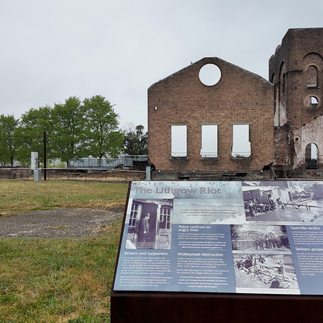
Charles Hoskins: The Iron Ambition That Built and Broke — Lithgow
19 hours ago
5 min read
1
6
0
Walk through the ruins of Lithgow’s blast furnace and you can feel the heat that once burned here. You can hear the rhythm of the shift whistle. You can almost see the silhouettes of men who poured their lives into the molten core of a nation being built.
These bricks are memory. These rivets are testimony.
And right at the centre of that history is one man — Charles Hoskins.
The businessman who made steel a national force
When G & C Hoskins Ltd took over the Lithgow works in 1908, the future changed course.
William Sandford had the vision — building Australia’s first modern blast furnace but Charles Hoskins brought the capital, scale, and political clout to push the industry to national significance.
He:
Expanded coke production
Built the second blast furnace in 1913
Increased employment and steel output
Turned Lithgow into an industrial powerhouse
Under his leadership, the steel that built rails, ships, bridges, and the machinery of a modern Australia was forged right here.
Progress with a human cost
Growth didn’t come with compassion.
Hoskins imposed strict discipline. Workers resented the bans on smoking, heavy-handed rules, and the suppression of union organising. When they stood up for dignity and fair conditions, they were met with hostility not negotiation.
The unrest culminated in the Lithgow strikes and the 1915 Riot, when workers, police and private interests clashed violently in the streets.
Families bore the consequences: arrests, blacklisting, hunger, the price of demanding basic respect.
These ruins remember that too.
Industrial siblings: Lithgow and Great Cobar
Lithgow was not alone in powering Australia’s industrial ambitions. During the same era that Charles Hoskins was building steel, the Great Cobar Copper Mining Syndicate — later Great Cobar Limited operated a vast network of mines, smelters, and processing facilities across New South Wales.
This included an electrolytic copper refinery, coal mine and coke works right here in Lithgow. Refining was the final stage of copper production: removing impurities after smelting to create high-purity metal for national infrastructure and manufacturing.
“Its operations included … an electrolytic copper refinery, coal mine and coke works, at Lithgow.”
By 1911, the refinery had closed and the company began exporting semi-processed copper overseas for final refining a stark reminder that when global markets shifted, communities like Lithgow carried the consequences.
Whether copper or steel, every advancement came at a human cost. Industry expanded faster than protections for those who made it possible.
From industrial risk to a system of compensation
Lithgow’s story isn’t just about steel. It’s also about the rise of systems designed to manage industrial harm and the ways those systems sometimes fail the very people they were built to protect.
The turning point in New South Wales came in 1926, with the Workers’ Compensation Act 1926. It introduced compulsory insurance for employers and a dedicated tribunal to adjudicate claims.
Opposition to the Bill from the insurance industry was fierce:
“The Workers’ Compensation Bill 1926 had an unprecedented hostile reception… a deputation from the Accident Underwriters Association of New South Wales representing 71 insurance companies objected…”— NSW Parliamentary Library
In response, Premier Jack Lang made a defining announcement:
“The Treasury Insurance Branch would enter into competition for the business as the Government Insurance Office. It was expected that this would eliminate the excessive charges by insurers.”— NSW Parliamentary Library
The Government Insurance Office of New South Wales (GIO) was born, a state-run insurer established to ensure workers’ compensation insurance could be delivered fairly and reliably.
Industrial expansion like Lithgow created the risks.Government intervention tried to contain them.
But the power imbalance didn’t disappear it simply evolved.
A decision that fractured a community
By the 1920s, Hoskins saw a bigger opportunity on the coast — Port Kembla.
He began shifting investment and infrastructure toward that new steelmaking hub. Lithgow’s furnace, once blazing with national ambition, began to cool.
Hoskins died in 1926. But the course he set continued under his sons.
By 1932, Lithgow’s iron and steel operations had closed. Overnight, a community that had built the nation was discarded. The economic shock rippled through generations.
Prosperity moved on. The people were left behind.
A warning carried forward
When industry was expanding faster than society could protect those who built it, the consequences were carved into coal seams, steelworks, and too many gravestones.
We stand here now in a different century, with different machines yet the questions remain hauntingly familiar.
As technology accelerates…As artificial intelligence reshapes work…As psychological injury rises faster than ever recorded…
Are we once again advancing faster than our ability to safeguard the people at the heart of progress?
This post is not about the future. It is about honouring those who paid the price in the past.
But history has a way of asking us whether we have learned anything at all.
The legacy that still lives here
Hoskins is celebrated in industrial history as a builder of national capability. But when we stand here among the twisted rust and fractured brick the story feels more complicated.
Because progress that isn’t shared is not progress. Because industries built on the backs of workers should never abandon them. Because this history echoes every time a modern injured worker is told their wellbeing is secondary to a spreadsheet.
Lithgow shows us the pattern:
Ambition without accountability
Profit without safety
Systems that use people — then move on
From the GIO to modern claims management
The Government Insurance Office wasn’t just an act of protection it was a shift of power. The state became both regulator and insurer of workplace injury.
Over time, the administration of this safety net became more complex. One organisation that emerged from this lineage was Employers Mutual Limited established in 1910 as a workers’ compensation mutual, and today a major claims management agent in New South Wales.
The architecture built nearly a century ago still governs the lives of today’s injured workers often with the same suspicion and imbalance of power that once defined these very industrial yards.
Why Shattered is telling this story
When we look back, the message is painfully clear:
If the people who build the nation are not protected, the nation is built on harm.
That’s why we are here, filming, listening, remembering.
Because the past doesn’t stay in the past. It is alive in the systems still breaking people today.
And when you stand in Lithgow’s ruins and hear the wind pushing through the old furnace windows…it sounds a lot like a story demanding to be told.
Reform or 'modernisation' won't fix this system. It was built on hostility and that ethos remains today.










